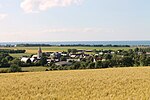British Normandy Memorial
2021 establishments in France2021 establishments in the United Kingdom2021 sculpturesBritish military memorials and cemeteriesBronze sculptures in France ... and 4 more
Death in NormandySculptures of men in FranceStatues in FranceWorld War II memorials in France

The British Normandy Memorial is a war memorial near the village of Ver-sur-Mer in Normandy, France. It was unveiled on 6 June 2021, the 77th anniversary of D-Day, and it is dedicated to soldiers who died under British command during the Normandy landings. The memorial records the names of 22,442 people from more than 30 countries under British command who were killed in Normandy from 6 June to 31 August 1944 .
Excerpt from the Wikipedia article British Normandy Memorial (License: CC BY-SA 3.0, Authors, Images).British Normandy Memorial
Allée Hector Berlioz, Bayeux
Geographical coordinates (GPS) Address Website External links Nearby Places Show on map
Geographical coordinates (GPS)
| Latitude | Longitude |
|---|---|
| N 49.338229 ° | E -0.537598 ° |
Address
British Normandy Memorial
Allée Hector Berlioz
14114 Bayeux
Normandy, France
Open on Google Maps









